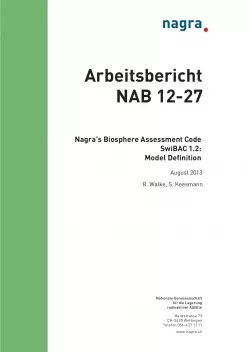
Arbeitsbericht NAB 12-27
Nagra's Biosphere Assessment Code SwiBAC 1.2:Model Definition
This report documents the conceptual and mathematical basis for a compartment model used by Nagra for representing the distribution of radionuclides released from a deep geological repository in the biosphere and for calculating potential effective radiation doses to persons. The model is implemented in a software application and is referred to as the Swiss Biosphere Assessment Code, SwiBAC. SwiBAC builds on Nagra's previous biosphere model TAME, hence, the report draws together a description of the conceptual and mathematical basis for the biosphere model based on previous Nagra reports.
The conceptual model for SwiBAC is based on radionuclide releases to a generic, agricultural biosphere system with the components near-surface aquifer, surface water, rooting zone soils and deeper soil horizons. These components are represented by one or several compartments between which transport can take place in solution and/or with fluxes of solid materials. Radiation doses are evaluated based on the modelled concentrations of radionuclides in the biosphere system. Conservative assumptions are used to ensure that potential doses are not underestimated, including that (i) all food consumed is grown locally and that (ii) the representative person resides in the region of highest concentrations during the entire year. The following exposure pathways are considered:
- consumption pathways:
- drinking water
- freshwater fish
- meat, eggs, milk and dairy products
- grain, green vegetables, root vegetables and fruit
- environmental exposures:
- external irradiation
- inhalation of radioactive dust or radioactive gas having escaped from the rooting zone
